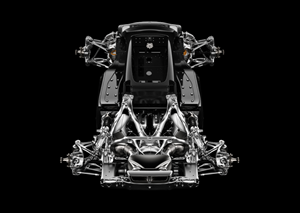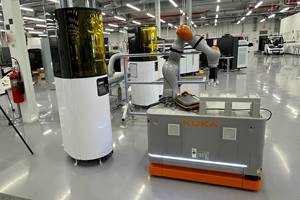3D Printing the World's Smallest Flow Measurement Probes
Vectoflow has found its niche in 3D printing flow measurement probes featuring up to five holes on a probe head diameter as tiny as 0.9 mm.
Share
Flow measurement probes gage and predict the speed and angle of attack of an airflow in aircraft and turbo-machinery. The accuracy of prediction of flow is high using conventionally manufactured multi-hole probes, but this accuracy can even be enhanced by manufacturing these probes using powder-bed fusion technology, which helps to, for instance, create turbine blades designed to obtain the desired three-dimensional flow pattern. By measuring differential pressures at the head of the probe, total and static pressure, the angle of attack and velocity of flow can be determined, whether installed in gas turbines, aircraft engines, drones or racing cars.
“The smaller and the more customized the probe, the less the measurement deviation,” explains Katharina Kreitz, one of the three founders of Munich-based Vectoflow. Together with colleagues Christian Haigermoser and Florian Wehner, Kreitz specialized in developing and manufacturing complex flow measurement probes.
“While the probes seem relatively small and fragile, they have to withstand extreme stresses and continue to function reliably at all times, especially in aircraft, where speed is a major factor,” she explains. “During our studies and various projects at renowned companies like Airbus we were quite involved with fluid dynamics but we were all facing the same problem: probes that were not suitable for a specific application, probes that broke easily, software that was almost impossible to understand despite having a PhD in aerodynamics. So we thought there had to be a better solution.”
The solution was additive manufacturing. Using powder-bed fusion technology, the company has developed a unique expertise in manufacturing customized probes that can be perfectly adapted to their application, are smaller, easy to integrate and more robust than conventionally made probes. “Conventional probes need to have their flow channels inside the tube soldered, weak points that often lead to breakage under immense pressure. Manufacturing the probes in one piece offers higher rigidity,” Kreitz says.
Smallest Probes Withstand the Speed of Sound
The smallest probe ever built, according to Kreitz, is a five-hole probe featuring a head diameter of 0.9 mm. There are five tiny independent channels inside this tube, measuring the angle of attack with an accuracy of 1° at a velocity range of 3 m/sec. up to Mach 2, from -50°C up to 1,200°C. But how is it possible to print such an intricate part made of titanium, Inconel or stainless? “For many of our products we are using standard metal AM technology from e.g. EOS or Trumpf,” Kreitz says. “But to make these extremely small parts with such a complex internal geometry considering the diameter, we use a special machine, using powder with a particle size smaller than dust (less than five microns).” The process is conducted in a special atmosphere and according to Kreitz it takes about a full day to print such a small tube because the powder handling is very complicated as the extremely fine dust exposes the worker to health hazards. As a result, the powder is fed to the machine via a special mechanism, using special equipment and gloves.
“With a lot of research and experience anyone could build these parts,” she says. “But anyone could also build his own car. It really takes a lot of experience, special design, considerations how to place the part on the built plate so the channels keep separated from each other inside the tube.”
All of the measuring probes manufactured by Vectoflow can be combined in rakes, leading to a higher spatial resolution (see the photo, above). Here, computational fluid dynamics (CFD) analysis and the flexibility of powder-bed fusion technology allows for an optimum design, where the probe heads are aligned and oriented according to the flow and angle of attack. So-called Kiel probes, an enhanced development based on traditional flow measurement probes, can also be combined in rakes. They enable accurate measurements to be taken, for example, during extreme flying maneuvers or when engines are in a banked position. However, the stresses on the component then increase even further. This is especially the case in the engine, due to the higher thermal loads.
“Our customer, a European research company in the aerospace industry, experienced ongoing problems with probes fracturing because they were made up of multiple parts, which made them unstable. We manufacture our probes in a single piece in order to avoid this type of problem," Kreitz explains. “Additive manufacturing allows us to produce Kiel probes in a single piece. This enables us to implement special functionally integrated designs and attain very small channel and overall sizes."
When modeling the components, Vectoflow also attaches great importance to minimizing the number of possible disruptive factors and their effects, for example the development of undesirable secondary noise, as acoustics measurement was also part of the remit in this case. The engineers also found effective solutions relating to thermal load capacity thanks to the nature of the layered production with the EOS M 290, for instance. The thermal elements measure the temperature of the respective measuring units. The nickel-chromium alloy is even able to withstand high temperatures of up to the required 1,000°C and continue to be fully functional at twice the speed of sound.
Post-Production Treatment
Vectoflow also subjected the components to extensive post-production treatment to optimize the product quality. While many probes do not require any or much post-treatment, specially developed processes like the Micro Machining Process (MMP Technology) give the Kiel probes their extremely smooth surfaces and perfect finish. The deburring/polishing method is a mechanical-physical-chemical surface treatment applied to items placed inside a treatment tank. This optimizes the aerodynamic quality of the probe such that their functions—measuring pressures and temperatures in the boundary layer of the air flowing from the jet engine—are not impaired.
“We received very positive feedback. Unlike probes manufactured using the traditional machining process, our sample was impressively robust,” Kreitz says. “Our component is 150 percent more rigid than conventionally made parts. Moreover, the extremely low thickness, together with the improved aerodynamic design and post-treatment played a major role in allowing the user to obtain very precise measurements."
Related Content
Aluminum Gets Its Own Additive Manufacturing Process
Alloy Enterprises’ selective diffusion bonding process is specifically designed for high throughput production of aluminum parts, enabling additive manufacturing to compete with casting.
Read MoreDivergent Technologies Eyes High-Volume, Optimized Automotive Production Through Additive
While some automotive OEMs are using additive here and there, Divergent Technologies is basing its vehicles on 3D printed structures.
Read MoreHow Additive Manufacturing Is Transforming EVs and Transportation: AM Radio #23
As 3D printing is adopted into the electric vehicle (EV) market, it is not just vehicles that are being reshaped. In this episode of the AM Radio podcast, we discuss additive manufacturing and the future of transportation.
Read MoreAutonomous Cobot Automation Increases Production 3D Printer Output for Ford (Includes Video)
A mobile robot that travels to each Carbon machine to unload builds lets the automaker run an additional three to four builds per machine per day. Autonomous robots fit well with 3D printing, but their role in production will extend beyond just the additive machines.
Read MoreRead Next
3D Printing Brings Sustainability, Accessibility to Glass Manufacturing
Australian startup Maple Glass Printing has developed a process for extruding glass into artwork, lab implements and architectural elements. Along the way, the company has also found more efficient ways of recycling this material.
Read MoreHybrid Additive Manufacturing Machine Tools Continue to Make Gains (Includes Video)
The hybrid machine tool is an idea that continues to advance. Two important developments of recent years expand the possibilities for this platform.
Read More4 Ways the Education and Training Challenge Is Different for Additive Manufacturing
The advance of additive manufacturing means we need more professionals educated in AM technology.
Read More

.JPG;width=700;quality=80)
.JPG;width=860)
.JPG;width=860)
.JPG;width=860)




















